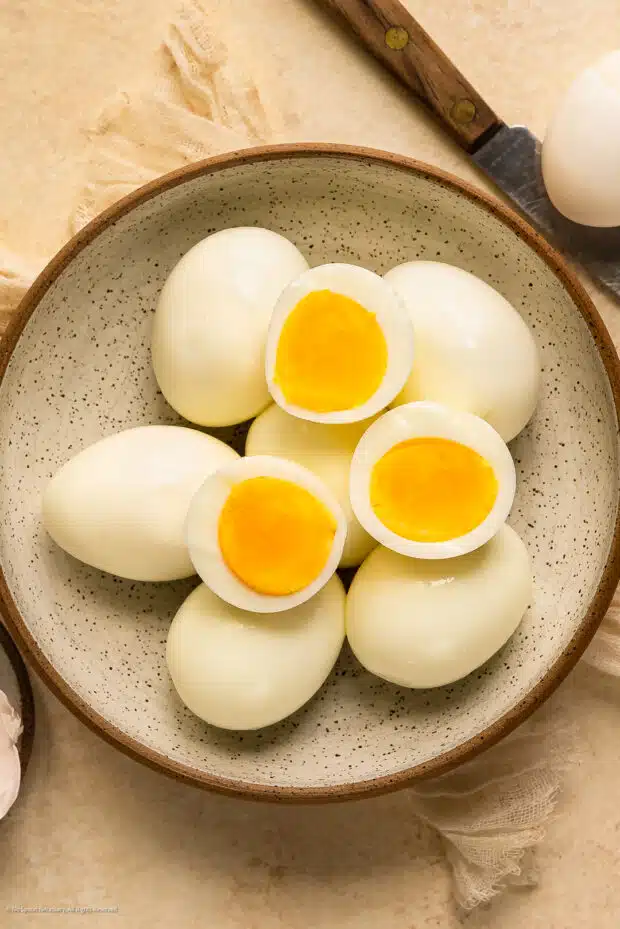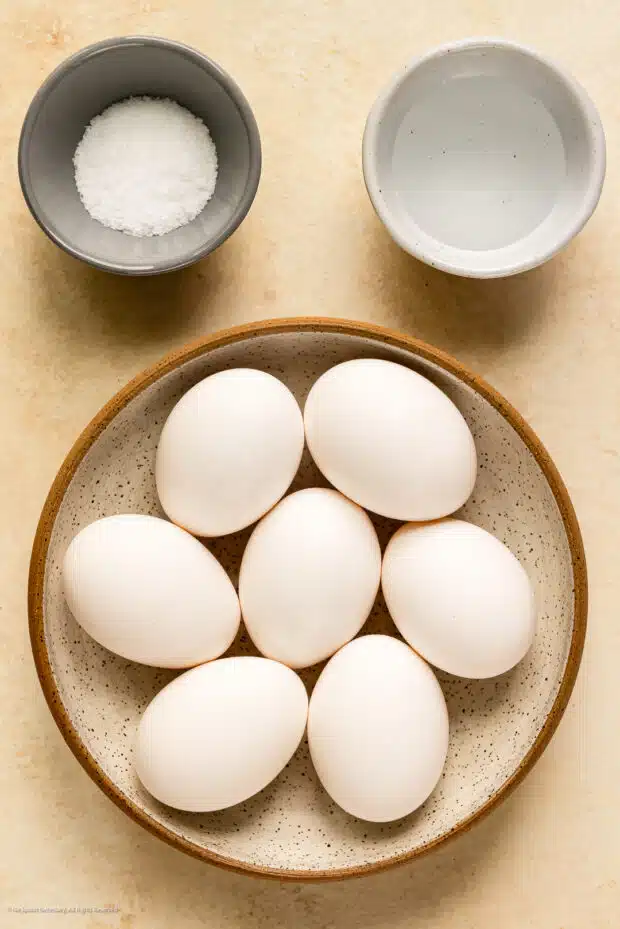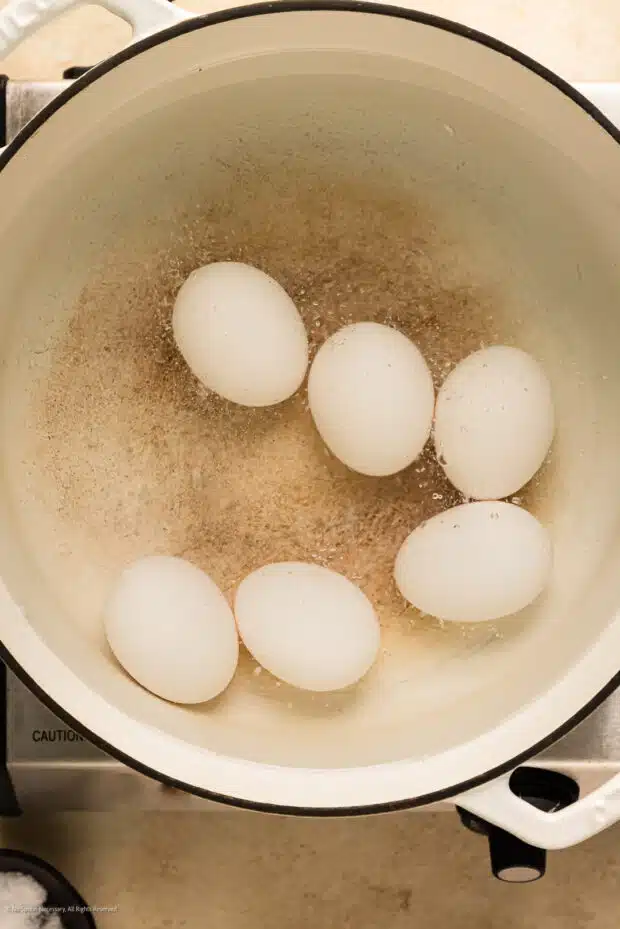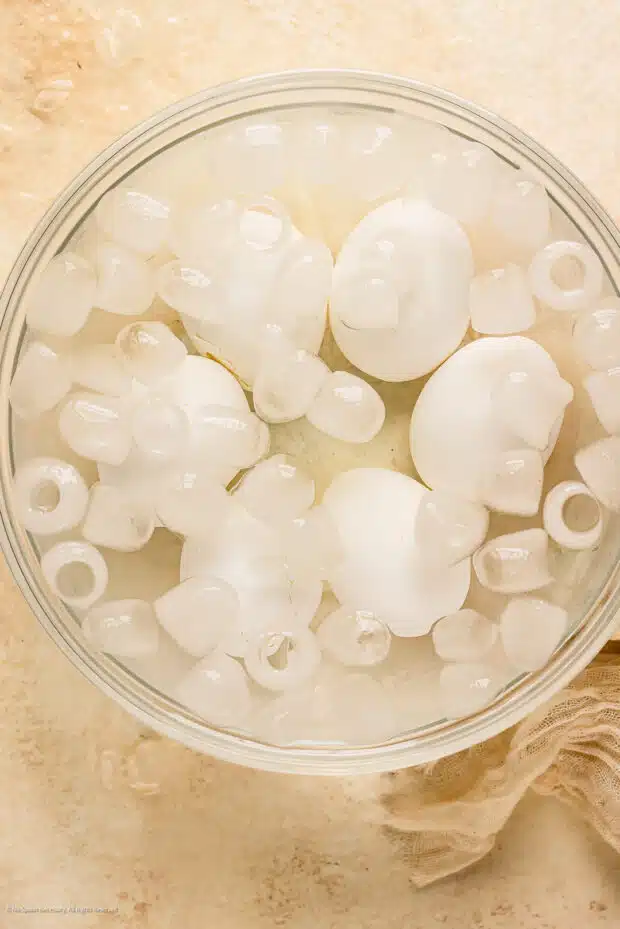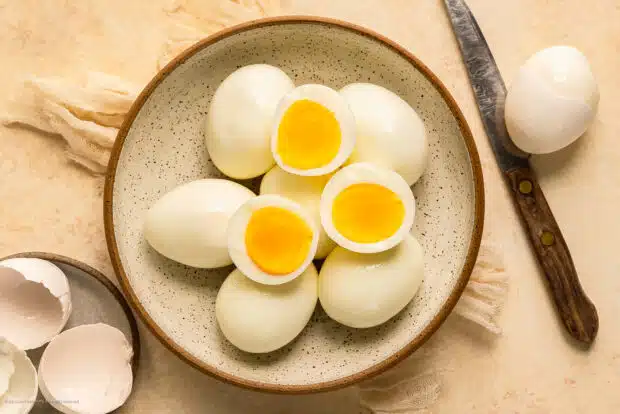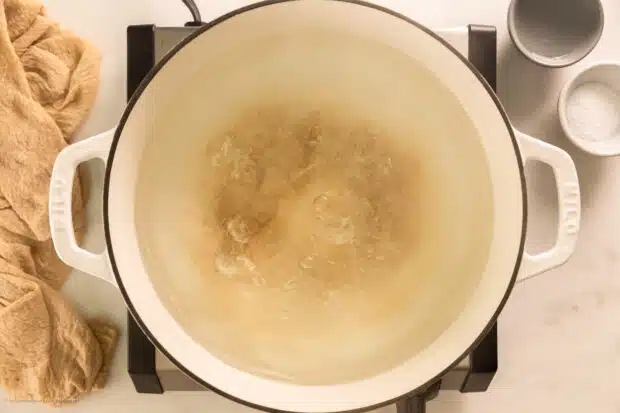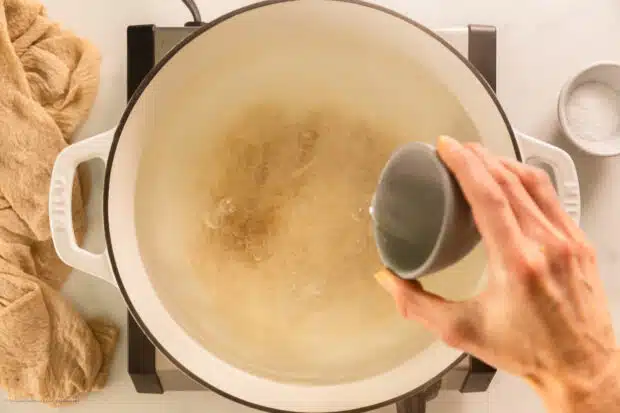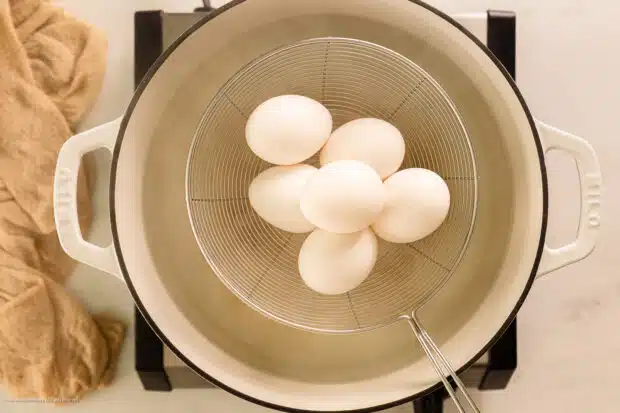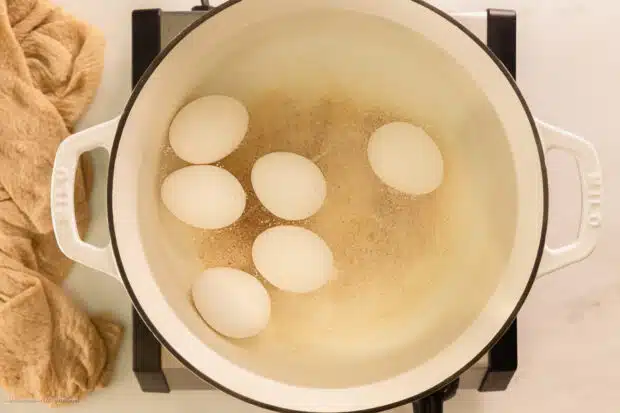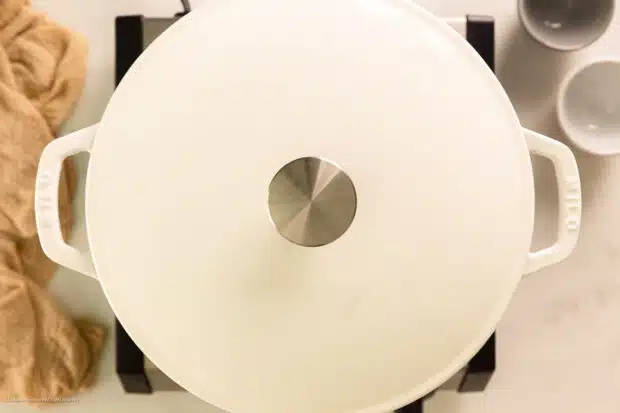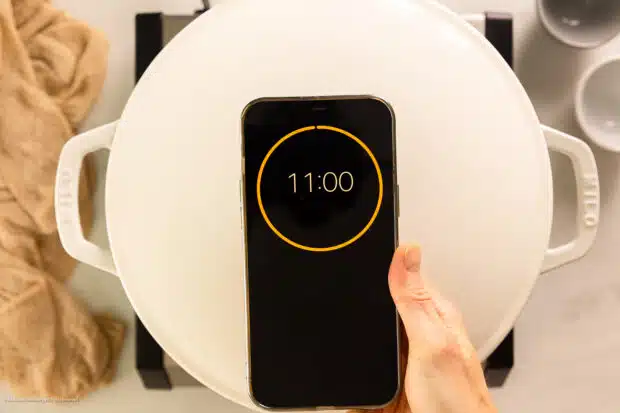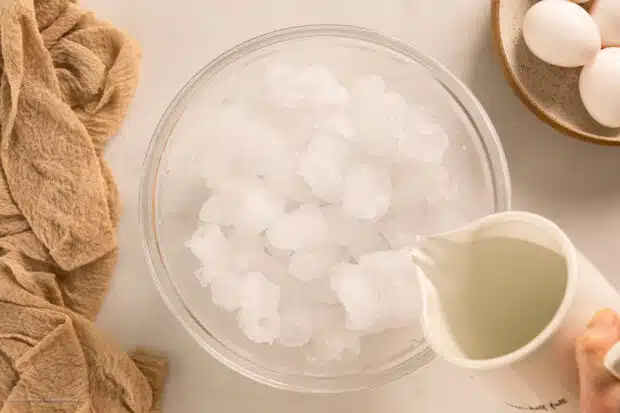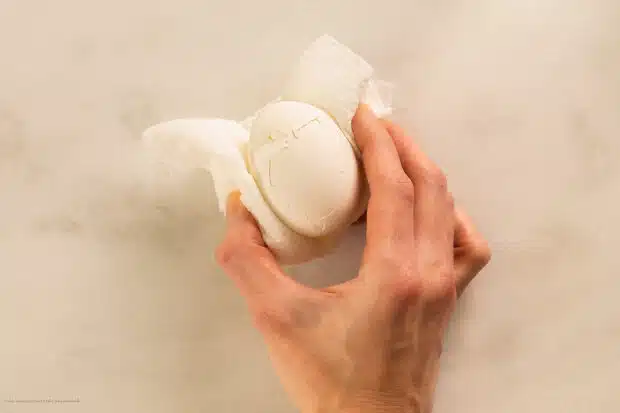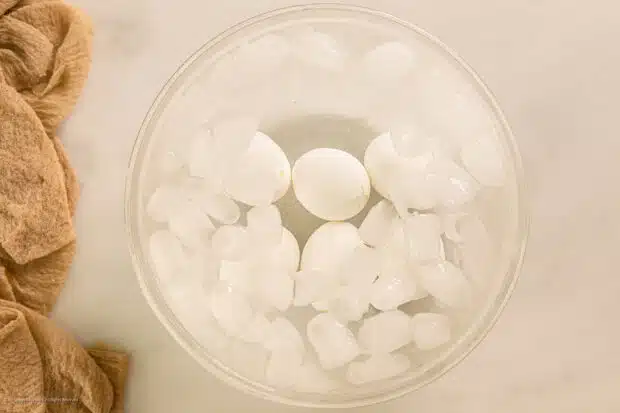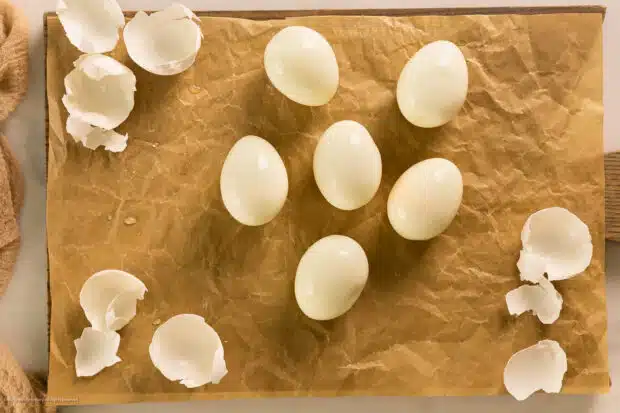This post may include affiliate links. Thank you for your support.
Mastering the art of crafting perfect, easy-to-peel hard boiled eggs is a worthwhile endeavor for any home cook. Bid adieu to elaborate contraptions and convoluted procedures – armed with basic science and a handful of straightforward steps, you’ll learn my foolproof method for How to Make Easy-Peeling Hard Boiled Eggs.
Table of Contents
- About this tutorial for easy to peel hard boiled eggs
- Ingredients and equipment for easy peel hard boiled eggs
- How to make hard boiled eggs that peel easy
- How to easily peel hard boiled egg
- Expert tips for boiling eggs
- FAQs: hard boiled eggs, easy peel
- How long do you hard boil an egg for?
- How long to hard boil 7 eggs?
- What makes hard boiled eggs easy to peel?
- Why are older eggs better for hard boiling?
- Cold start or hot start?
- Will hard boiled eggs float when done?
- Do hard boiled eggs go bad?
- Do hard boiled eggs in the shell have to be refrigerated?
- What is the best way to store hard boiled eggs?
- Can hard boiled eggs be frozen?
- Serving perfect easy to peel hard boiled eggs
- How to store perfect hard boiled eggs
- How to Hard Boil Eggs
About this tutorial for easy to peel hard boiled eggs
I’ve heard the tale time and again — whenever you make hard boiled eggs that are going to be mashed into egg salad, they peel like a dream. But, when you’re making something where the egg should look flawless (like deviled eggs, perhaps?) the gee-dang shells cling to the whites for dear life, leaving you with pock-marked eggs that look like they were prisoners at Guantanamo.
I’m not sure why the universe plays these tricks, but it sure is mean! Luckily, I’ve learned the tricks to leaving all that nonsense behind. My recipe for easy-to-peel hard boiled eggs yields perfectly fluffy, pale yellow yolks and silky smooth exteriors — EVERY SINGLE TIME.
So, stop living your kitchen life like the black and white part of an infomercial. Step into my technicolor dreamland where shells effortlessly release for their eggs, no special equipment needed.
Ingredients and equipment for easy peel hard boiled eggs
This easy to peel hard boiled eggs recipe yields a result so consistent it seems almost magical. And the best part? You don’t need any extravagant contraptions or convoluted techniques. Here’s what to grab:
- Eggs – This is gonna sound weird, but opt for older eggs (e.g. those from the grocery store) over farm fresh. As it happens, older eggs always peel easier than those that are fresh from the bird. 🤷♀️
- Water – If possible, start with filtered water for the best flavor. Also, make sure to start with cool water from the tap; hot water leaches out more of the minerals from your pipes!
- Vinegar – Adding a touch of acid to your egg jacuzzi increases the pH, which helps the yolks set more firmly. It also adds a faint flavor, so choose a vinegar you enjoy — I typically like distilled white vinegar here because it’s inexpensive, but you can also use apple cider vinegar, white wine vinegar, or even lemon juice.
- Salt – Egg shells are porous, which means the water they bathe in will actually touch the egg inside. Adding salt to the pot ensures your easy peel hard boiled eggs are perfectly seasoned all the way through.
- Pot – Opt for one that is large enough to fit the number of eggs you’d like to hard boil without crowding them.
- Slotted Spoon or Colander – Useful for quickly fishing out the hard boiled eggs so you can dunk them in an ice bath.
- Large Bowl – For your ice bath.
How to make hard boiled eggs that peel easy
Step 1: Boil water. Add 3 quarts (12 cups or 96 ounces) of water to a large saucepan. Place the pan over high heat on the stove, cover, and bring to a full, rolling boil.
Step 2: Add vinegar and salt. Once the water is boiling, uncover the pan and add the vinegar and the salt.
Step 3: Add eggs. Let the water return to a boil. Once boiling, use a slotted spoon to carefully lower all the COLD eggs into the pot.
Step 4: Boil eggs for 30 seconds. Let the eggs boil for exactly 30 seconds. Pro Tip: An egg timer comes in handy here!
Step 5: Cover and simmer. After 30 seconds, cover the saucepan, and reduce the heat to LOW so the water barely maintains a simmer.
Step 6: Set timer and cook. Let the eggs cook in the pot of water, covered, for 6 minutes for soft-boiled eggs (barely set whites and very runny yolks), 8-9 minutes for medium-boiled eggs (set whites and jammy yolks), and 11 minutes for hard-boiled eggs (set whites, pale yellow, firm yolks).
Step 7: While eggs are cooking, set up an ice water bath. Fill a large bowl halfway with ice cubes and then add enough cold water to cover the ice. Set the ice bath aside.
How to easily peel hard boiled egg
Step 8: Gently crack eggs (hard-boiled only). Use a slotted spoon to remove the eggs from the pan. Once you’ve removed the egg, carefully and gently tap the egg against the counter to lightly crack the shell in a few places. (Note: Be careful as eggs are hot!! I use a paper towel to hold the egg to protect my fingers, but an oven glove works better.)
For soft-boiled eggs, simply remove them from the simmering water with a slotted spoon and proceed to next step. DON’T try to crack the eggs or you’ll end up with runny yolk all over the place. You’ve been warned!
Step 9: Halt cooking with the ice bath. Once you’ve gently cracked the shell in a few places, add the eggs to the large bowl of ice water. Let the eggs sit in the ice bath for at least 5 minutes. Alternatively, you place the eggs in their ice bath in the fridge. Or you can skip this step entirely if you prefer a warm hard boil egg.
Step 10: Peel eggs the rest of the way. To peel the cooked egg, gently tap the egg against the counter, rotating the egg in your hand to make sure you crack the shell all over. Next, hold the egg underneath a stream of gently running cool water and use your hands to peel the shell off the egg, discarding the shells.
Step 11: Eat or store boiled eggs. Enjoy or store any unused perfect easy to peel hard boiled eggs.
Expert tips for boiling eggs
- Start with COLD eggs as they will cook more consistently and gently; they’re also less prone to cracking.
- Use older eggs versus fresh eggs. Generally, older eggs are the easiest to peel because the pH level of the whites rise as the eggs age, which makes the membrane adhere less strongly to the shell. (Scroll down to learn the “why” behind this egg science.)
- Use an ice bath. Chilling eggs immediately after cooking ensures that they turn out perfectly shaped, without any air-space indentations in sight! It also halts the cooking process, making sure your yolks stay pale yellow instead of turning the dreaded grey-green shade.
- Chill until *just* cool to touch. Chill the eggs in an ice water bath until they are just cool enough to handle. Warm eggs release from their shell much easier than cold eggs!
- Roll to crack. Gently tap and roll the egg around on the counter to crack the shell all the way around. Then, place the cracked eggs back in the ice water bath for a minute. This allows the water to seep under the shell, which will make the egg much easier to peel!
- Peel under running water. Place the eggs under gently running water for easy-peel eggs every single time!
FAQs: hard boiled eggs, easy peel
How long do you hard boil an egg for?
If you’re looking for perfect easy to peel hard boiled eggs with pale yellow yolks, I find 11 minutes to be perfect. For a set white with a saffron yellow, jammy yolk, go for about 8-9 minutes. If you like a soft-boiled egg with a runny yolk (like the kind British folks eat out of an egg cup with toast “soldiers”), 6 minutes is ideal.
Remember that these time ranges are approximate and can be adjusted slightly based on factors like egg size, altitude, and personal preference. Once your eggs have reached the desired level of doneness, promptly transfer them to an ice water bath to halt the cooking process and make peeling easier.
How long to hard boil 7 eggs?
When it comes to boiling multiple eggs at once, the cooking time remains relatively consistent. Whether you’re boiling 1 or 12 eggs, the duration stays the same due to the limited impact of batch size on cooking time.
What makes hard boiled eggs easy to peel?
There are actually a few science-backed secrets for how to make easy peeling hard boiled eggs:
- Cold eggs, boiling water. Easy-to-peel hard boiled eggs are the result of adding COLD eggs to hot boiling water. (See below for cold start vs. hot start eggs.)
- Increase the pH. A more acidic white will set more firmly, ensuring the shell comes off more easily. Start with older eggs which have a naturally higher pH, then add some acid to your cooking water to raise it further.
- Use an ice bath. Shocking the cooked eggs in cold water both stops the cooking process, and also helps the egg whites set without any air-bubble indents.
- Let water under the shell. After you’ve shocked the hard-boiled eggs, gently tap them all over so there are cracks over the entire surface. Then, re-submerge them. The water will permeate through the cracks, helping to lift the shell from the whites.
- Use running water. This goes back to point #3 — water helps to gently separate the egg from the shell, so continue to let water run over them as you peel.
Why are older eggs better for hard boiling?
While it may sound odd and totally counterintuitive, older eggs are much easier to peel.
Fresh egg whites bond strongly to the egg’s inner shell membrane. However, as an egg ages, the PH level rises causing the white to become more alkaline. And, the more alkaline the egg white, the easier it is to peel off the shell.
Now you may be wondering how to find old eggs. Well, if you purchase eggs at the supermarket, they are most likely old enough as the USDA allows for a 30 day storage at the factory and another 30 days for the best-by date. However, if you buy your eggs at the farmer’s market or directly from a farmer, you will want to ask when the eggs were laid. You’ll want to let fresh eggs sit for at least 2 weeks before attempting to boil – IF you want an egg that’s easy to peel.
Cold start or hot start?
There’s a lot of discussion about whether cold starting or hot starting eggs will lead to an easier peel. Let’s discuss:
Hard boiled eggs that are easy to peel are the result of adding COLD eggs to a BOILING HOT START.
While it’s unclear where the cold start myth started, some point blame to the humble potato since it’s potatoes that need a cold start for even cooking and creamier texture.
Regardless, if you need cooked eggs that are easy to peel and shell, you’ll want to use a hot start. This is especially true for things like Easter eggs or deviled eggs, where you want the egg white to have a beautiful appearance, without any chunks of egg white missing.
Will hard boiled eggs float when done?
Yes, hard-boiled eggs can float, but not necessarily when they are done cooking. The floating of an egg is more related to its age than its cooking status. When it comes to determining the doneness of hard-boiled eggs, the floating test isn’t the most reliable method. Instead, rely on the clock to help you determine when to pull the eggs from the boiling water!
Do hard boiled eggs go bad?
Yep, hard boiled eggs can go bad, just like any other food. Make sure to refrigerate any leftovers to prevent bacterial growth and spoilage.
Do hard boiled eggs in the shell have to be refrigerated?
Hard boiled eggs in the shell have a longer refrigerated life of around 5-7 days, whereas peeled boiled eggs should be consumed within a day. However, both need to be stored in the fridge.
What is the best way to store hard boiled eggs?
Storing hard-boiled eggs is easy! Once they’re cooked, let them cool and then keep them in the fridge. You can store them in their shells or peeled – just make sure they’re in an airtight container to prevent any odors from seeping in.
Can hard boiled eggs be frozen?
As for freezing, it’s not recommended to freeze hard-boiled eggs in their shells. The water content in the eggs can expand when frozen, causing the shells to crack. However, you can freeze hard-boiled egg yolks and whites separately.
Serving perfect easy to peel hard boiled eggs
Question: What are hard boiled eggs good for? Answer: SO MANY THINGS. Here are some of my favorites recipes used a hard boiled egg:
- Use your homemade boiled eggs to make fresh deviled eggs (Bacon Deviled Eggs, Crab Deviled Eggs, Fancy Deviled Eggs) or mimosa eggs.
- Chop them up and add them creamy summer potato salads and pasta salads, like this Pea Pasta Salad with Bacon or my all time favorite No Mayonnaise Potato Salad.
- Dice up your eggs and add them to any and all of your favorite leafy green salads, like this Avocado Bacon Lettuce Salad, Italian Salad, Pea Lettuce Salad with Chicken, or Brussels Sprouts Salad. Just don’t forget the best oven croutons.
- I’d be remiss if I didn’t mention using your hard boil eggs to make classic egg salad and egg salad sandwiches.
- It’s also a delicious addition to tuna salads and tuna macaroni salads.
Ideas for using hard cooked eggs
- Give your boiled eggs a fun and flavorful makeover with these turmeric pickled eggs.
- If you aren’t into devil eggs, make deviled potatoes instead! Simply add cooked potato to your favorite deviled egg filling. Then stuff that mixture into potato skins, garnish with a little paprika and chow down.
- One of my favorite ways to use up leftover hard-boiled eggs is to use them in hummus. To make egg hummus, simply add hard boiled eggs to your favorite hummus recipes.
How to store perfect hard boiled eggs
- You can store hard-boiled eggs that are still in their shell in the fridge for up to 5-7 days.
- Once you remove the shell, you can store the hard-boiled egg in the fridge for 1 day.
Craving MORE? Follow all the deliciousness on Facebook, Pinterest and Instagram!
How to make hard boiled eggs that are easy to peel👇
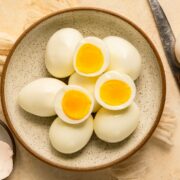
How to Hard Boil Eggs
Equipment
- 1 Large Saucepan (for hard boiled eggs)
- 1 Slotted Spoon (for adding and removing eggs to boiling water)
- 1 Large Bowl (for shocking hard boiled eggs)
Ingredients
- 6 Large Eggs – COLD (SEE NOTES)
- 2 TBS White Vinegar
- 1 TBS Kosher Salt
Instructions
- Boil water: Add 3 quarts (12 cups or 96 ounces) of water to a large saucepan. Place the pan over high heat, cover, and bring to a full boil.
- Add vinegar and salt: Once the water is boiling, uncover the pan and add the vinegar and the salt.
- Add eggs: Let the water return to a boil. Once boiling, use a slotted spoon to carefully lower all the COLD eggs into the pot.
- Boil eggs for 30 seconds: Let the eggs boil for exactly 30 seconds.
- Cover and simmer: After 30 seconds, cover the saucepan, and reduce the heat to LOW so the water maintains barely maintains a simmer.
- Set timer and cook: Let the eggs cook, covered, for 6 minutes for soft-boiled eggs and 11 minutes for hard-boiled eggs.
- While eggs are cooking, set up an ice water bath: Fill a large bowl halfway with ice cubes and then add enough cold water to cover the ice. Set the ice bath aside.
- Gently crack eggs (hard-boiled only): Use a slotted spoon to remove the eggs from the pan. Once you’ve removed the egg, carefully and gently tap the egg against the counter to lightly crack the shell in a few places. (Note: Be careful as eggs are hot!! I use a paper towel to hold the egg to protect my fingers, but an oven glove works better.) For soft-boiled eggs, simply remove them from the simmering water with a slotted spoon and proceed to next step. DON’T try to crack the eggs or you’ll end up with runny yolk all over the place.
- Add eggs to ice bath: Once you’ve gently cracked the shell in a few places, add the eggs to the bowl of ice water. Let the eggs sit in the ice bath for at least 5 minutes. Alternatively, you place the eggs in their ice bath in the fridge. Or you can skip this step entirely if you prefer a warm hard boil egg.
- Peel eggs: To peel the cooked egg, gently tap the egg against the counter, rotating the egg in your hand to make sure you crack the shell all over. Next, hold the egg underneath a stream of gently running cool water and use your hands to peel the shell off the egg, discarding the shells.
- Eat or store: Enjoy or store any unused boiled eggs (still in their shell) in the fridge for up to 5-7 days. (Note: Once you remove the shell, you can store the hard-boiled egg in the refrigerator for 1 day.)
Notes
- Start with COLD eggs as they will cook more consistently and gently; they’re also less prone to cracking.
- Use older eggs as they will be easier to peel than fresh ones. (Tip: I typically purchase a carton of raw eggs at the store and leave them in my fridge for a week or two before hard boiling for the easiest peeling.)
- Why vinegar? Vinegar increases the acid PH levels in the water which helps holds the eggs whites together. Vinegar also adds slight flavor.
- Why salt? Kosher salt (or coarse sea salt) helps flavor the eggs.
Nutrition
Did you make this recipe?
Mention @nospoonnecessary on Instagram and tag it #nospoonnecessary!
©No Spoon Necessary. All images and content are under copyright protection. Please do not use any images without prior permission. If you want to reference this recipe please link directly back to this post.

